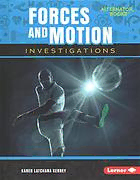
Forces and motion investigations PDF
Preview Forces and motion investigations
FORCES MOTION AND I N V E S T I G A T I O N S KAREN LATCHANA KENNEY THIS PAGE INTENTIONALLY LEFT BLANK FORCES MOTION AND I N V E S T I G A T I O N S KAREN LATCHANA KENNEY Lerner Publications Minneapolis To our future scientists and their unknown discoveries Content consultant: Kevin Finerghty, adjunct professor of Geology at State University of New York, Oswego; Earth science teacher at Pulaski Academy and Central Schools, Pulaski, New York Copyright © 2018 by Lerner Publishing Group, Inc. All rights reserved. International copyright secured. No part of this book may be reproduced, stored in a retrieval system, or transmitted in any form or by any means—electronic, mechanical, photocopying, recording, or otherwise—without the prior written permission of Lerner Publishing Group, Inc., except for the inclusion of brief quotations in an acknowledged review. Lerner Publications Company A division of Lerner Publishing Group, Inc. 241 First Avenue North Minneapolis, MN 55401 USA For reading levels and more information, look up this title at www.lernerbooks.com. Main body text set in Aptifer Slab Regular 11.5/18. Typeface provided by Linotype AG. Library of Congress Cataloging-in-Publication Data Names: Kenney, Karen Latchana. Title: Forces and motion investigations / by Karen Latchana Kenney. Description: Minneapolis : Lerner Publications, [2018] | Series: Key questions in physical science | Audience: Age 8–12. | Audience: Grade 4 to 6. | Includes bibliographical references and index. Identifiers: LCCN 2016045747 (print) | LCCN 2016046144 (ebook) | ISBN 9781512440089 (lb : alk. paper) | ISBN 9781512449570 (eb pdf) Subjects: LCSH: Gravity—Juvenile literature. Classification: LCC QC178 .K43 2018 (print) | LCC QC178 (ebook) | DDC 531/.11—dc23 LC record available at https://lccn.loc.gov/2016045747 Manufactured in the United States of America 1-42270-26127-3/10/2017 CONTENTS INTRODUCTION ULTIMATE BOUNCE 4 CHAPTER 1 WHERE DOES MOVEMENT COME FROM? 6 CHAPTER 2 WHAT KEEPS THE MOON FROM FLOATING INTO SPACE? 12 CHAPTER 3 WHAT MAKES THINGS MOVE? 18 CHAPTER 4 HOW DOES A ROCKET ESCAPE GRAVITY? 25 TRY IT! 28 GLOSSARY 30 FURTHER INFORMATION 31 INDEX 32 INTRODUCTION ULTIMATE BOUNCE Your team steps onto the court. It has wall-to-wall trampolines, and you’re about to play the ultimate game of dodgeball. Grab a ball and get jumping! You jump onto the trampoline and push the stretchy fabric down. It pushes back, launching you high into the air as you throw your ball at the other team. Forces are at the heart of the science behind trampolines. What’s happening with each bounce? Forces and motion are at work. Your first jump is the force that gets your motion going, and the force of the stretchy trampoline keeps you bouncing. Have you ever wondered about a trampoline’s bounce? Or why the moon keeps circling Earth? Curious scientists also ask these kinds of questions. They study the world and think about how it works. They test their ideas and come up with answers based on their evidence. Everything on Earth and beyond feels the effects of forces. 5 CHAPTER 1 WHERE DOES MOVEMENT COME FROM? How do you send a basketball flying into a hoop? You need to use force. The many different kinds of forces are all just a push or a pull. Forces can get things moving or make them stop. They’re the reason we have motion. EARLY THOUGHTS ON FORCES AND MOTION Forces have fascinated scientists It takes forces to make a basket, but scientists for centuries. Ancient Greek didn’t always understand philosopher Aristotle studied forces. what forces were or how they worked. 7 He hypothesized that an object’s motion was caused by its need to find more objects like it. Aristotle wondered whether rocks and soil were attracted to each other, since they were both made of earth. He tested his theory and observed it being confirmed in nature. Modern scientists know that rocks fall because of gravity. But Aristotle’s hypotheses gave later scientists lots of ideas to test. Aristotle’s early questions started to form our understanding of forces and motion. DIFFERENT FORCES Although he was wrong about the cause, Aristotle did understand that motion begins with a push or a pull. Aristotle thought objects on Earth were made of a combination of four elements: water, earth, air, and fire. He saw rocks fall to the ground and thought the motion was caused by the rock’s need to find more earth elements. 8 That push or pull is caused by different kinds of forces. Contact forces happen when two things touch. The force that helps you jump high on a trampoline is a contact force. Friction is the contact force that resists motion between things that are in contact. It helps us grip the ground when we walk, but it also slows things down. Italian artist and scientist Leonardo da Vinci wondered why heavier objects are harder to push or pull and move more slowly than lighter objects. When you jump on a trampoline, you push down on the trampoline and it pushes back at you. The springs stretch, and elastic force launches you into the air.
